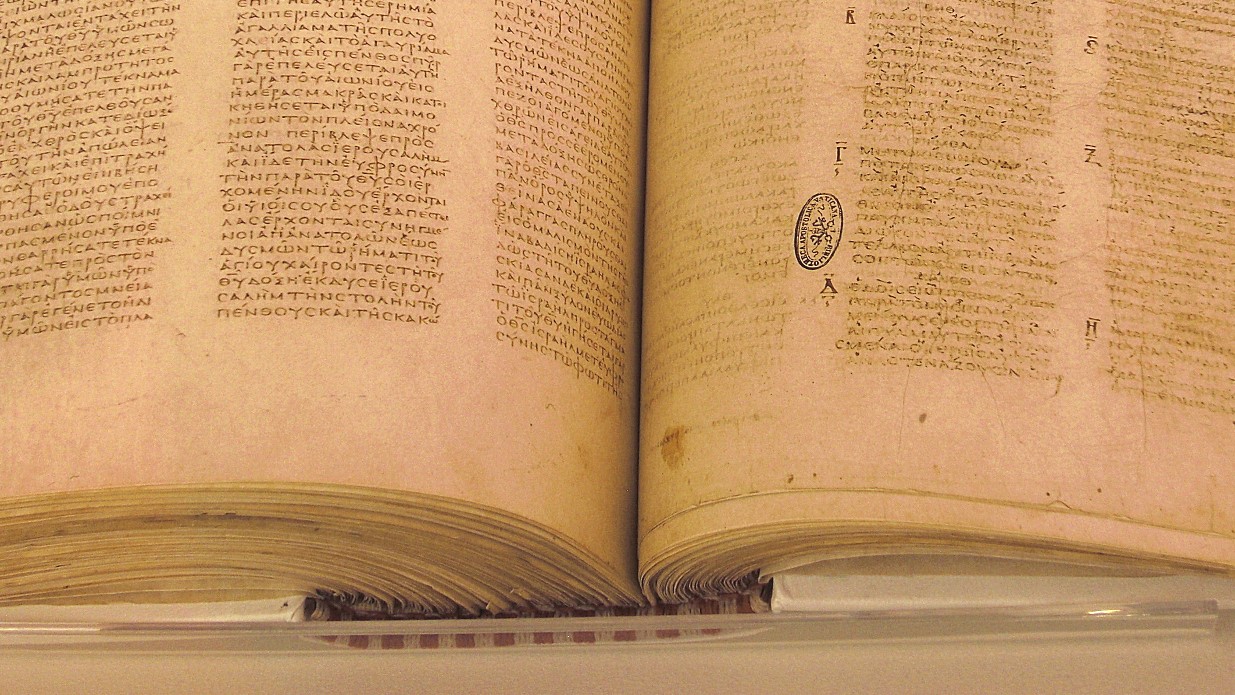

Deacon-structing the Gospels
Deacon Pedro
Monday, September 14, 2020

The Codex Vaticanus contains one of the oldest known complete versions of the New Testament. Photo by Leszek Janczuk on Wikimedia Commons. This photo has been cropped from the original and is used under license (CC BY-SA 4.0).
I remember, some 20 years ago, I went to see a production of a play called Bigger Than Jesus. The show was very well done, but, as often happens when non-Christians portray Christianity in the media, it contained many, many inaccuracies.
One of the claims that the playwrights made was that the Gospel writers based their accounts on hearsay and that they contradict each other.
I suspect most of you have heard people make this claim. I wonder if you know how to respond to them. How much do you know about the Gospels, how they were written and why there are discrepancies in their telling of the same stories?
Since September 21st is the Feast of St. Matthew (whose Gospel we have been reading on Sundays this year), and since we were just reading Mark and have just begun to read Luke in our Daily Readings at Mass, I thought it would be a good time to review the Gospels.
 Every week, Deacon Pedro takes a particular topic apart, not so much to explore or explain the subject to its fullness, but rather to provide insights that will deepen our understanding of the subject. And don’t worry, at the end of the day he always puts the pieces back together. There are no limits to deaconstructing: Write to him and ask any questions about the faith or Church teaching: [email protected]. Follow him on Facebook, Twitter and Instagram.
Every week, Deacon Pedro takes a particular topic apart, not so much to explore or explain the subject to its fullness, but rather to provide insights that will deepen our understanding of the subject. And don’t worry, at the end of the day he always puts the pieces back together. There are no limits to deaconstructing: Write to him and ask any questions about the faith or Church teaching: [email protected]. Follow him on Facebook, Twitter and Instagram.
Let’s look at the basics.
The word "gospel" simply means "good news" in Old English. In Greek, it's euangelion, which also means "good news". To share the Gospel is to share the Good News: It is to evangelize. There are four Gospels: Matthew, Mark, Luke, and John. The first three are called the “synoptic Gospels” because they are similar in their telling of the story. (This comes from the Greek word "synopsis", meaning "seeing together" or "a shared view", as opposed to the English word which means "a summary".) The Gospel of John stands out in style and form. It is generally accepted that the Gospels were not actually written by four guys named Mark, Matthew, Luke, and John, although they were likely written by their disciples, based on their teachings. It is also generally accepted that Matthew and John were the Apostles of that name. Mark was a disciple of Peter and travelling companion of Paul, and Luke was also a travelling companion of Paul (they both appear in the Acts of the Apostles and are mentioned in several Epistles. Read more on that in my series, Deacon-structing the Acts of the Apostles). If Matthew and John were Apostles, then their accounts are firsthand. It is possible that Luke and Mark were already around as disciples before the Resurrection, but if not, they were definitely among the first disciples of the Apostles. I would not say that their accounts are “hearsay”. The Gospels were written 40-70 years after the death of Jesus. The Gospel of Mark was written first. It is the shortest. It begins with Jesus’ public ministry, not giving any details of his infancy and birth. Matthew and Luke base their accounts on Mark’s. It is also likely that the Gospel of Mark (maybe the other 2 synoptics, as well) began only as an account of the Resurrection and then more was added (going backwards) as more and more information was necessary to tell the story better. The Gospels were written in Greek but for various reasons and for different audiences. They were written at a time when Judaism and Christianity were threatened. The Jewish Temple (the one rebuilt after the return from the Babylonian Exile and finished by Herod – the first one having been built by King Solomon and destroyed before the Babylonian Exile) had just been destroyed again, this time by the Romans (in AD 70). Over a million Jews were killed, and the rest were scattered all over the place. The city of Jerusalem was completely destroyed. When the Gospels have Jesus speaking about persecution or picking up your cross, we have to remember that these events had already taken place by the time they were written down and the persecution of Christians had already begun. Here’s some background that should help you with the Gospels. The Gospel of Matthew: It was written by Matthew (Luke and Mark refer to him as Levi, Luke: 5:27-28; Mark 2:13-14), a Jew, while he was in Antioch between AD 70 and 90. Matthew was a tax collector, called by Jesus to follow him early in his public ministry (Matthew 9:9). He would have witnessed most of the events he writes about. It is popular belief that Matthew was written for Jews in order to show that Jesus is the fulfillment of God's promise in the Old Testament. This is why he introduces Jesus as "a descendant of King David and of Abraham" (Matthew 1:1). Throughout the Gospel, Matthew makes reference to numerous Old Testament prophecies and quotes to explain Jesus' life: Jesus came to be the Saviour of the Jews (1:21), the Gentiles (4:13-16), and the whole world (28:19). The Gospel of Mark: It was written by Mark (cousin of Barnabas, according to Colossians 4:10), a companion of the Apostle Paul, around AD 70. St. Paul refers to a Mark several times in his letters: Colossians 4:10; 2 Timothy 4:11; Philemon 1:24. He is also referred to as John-Mark or simply John (see Acts 12:12, 12:25, 13:5, 13:13). Simon Peter refers to Mark as “my son” (see 1 Peter 5:13). It is not likely that he was literally the son of Peter (although, why not?) but the reference suggests intimacy. I’ve heard some people say that the Gospel of Mark is in fact the Gospel of Peter because Mark is writing the memories of Peter, with whom he settled in Rome. This could also explain why the Gospel of Mark is the most unforgiving in its portrayal of Peter. Experts say that Mark wrote his Gospel hastily, which is why it is so short. Mark's purpose was to focus on Jesus' actions instead of his words. He devotes a lot of his writing to the last week in Jesus' life and before then, several predictions of his coming death are mentioned. Mark depicts Jesus not just as a servant of God who came to do God's will but also as the Son of God. Mark very clearly was writing to encourage Roman Christians in a time of persecution. The Gospel of Luke: It was written by Luke, a Greek physician and travelling companion of St. Paul, between AD 80 and 100, probably from Caesarea (Paul refers to Luke three times: Colossians 4:14; Timothy 4:11; Philemon 1:24). He wrote the Gospel for someone named Theophilus in order to show the true humanity of Jesus and his place in history (Luke 1:1-4). Luke is writing for non-Jews, which is why this is a good Gospel for non-Christians to start with. Luke is careful to examine all the evidence very carefully and gives precise dates to the events that took place. Luke mentions many details not found anywhere else. Luke shows Jesus to be the perfect God-man whose genealogy can be traced right back to Adam (3:23-38). Luke tries to present Jesus as the greatest man in history and tries to prove that because of what Jesus taught and did and why he died, and because he rose from the dead, we should accept him as Lord. After finishing his Gospel, Luke writes the Book of Acts as a continuation of the story. The Gospel of John: It was written by John, the Apostle (the son of Zebedee, the brother of James), while in Ephesus between AD 90 and 110. John wrote his Gospel for the purpose that "all who read it might believe in Christ and thus have life through his name" (John. 20:31). John, like Mark, does not dedicate any time to Jesus’ infancy and birth but presents Jesus' life as pre-existent with the Father, showing him to be not just a great man but also God (see John 1). John also describes miracles and teachings not found anywhere else. He also dedicates quite a bit to Jesus' time after his Resurrection and before his Ascension. John really stresses Jesus as God. He refers to him as Light, Truth, Good Shepherd, the Resurrection and the Life, Living Water, and True Bread (to name a few). John's Gospel was written by someone who not only knew Jesus but knew him very well. Even though the author of John never actually says this, most scholars agree that “the disciple whom Jesus loved” is in fact John, the author of this Gospel.Discrepancies
As I wrote above, all four accounts were written for different reasons, under different circumstances, in different styles, and highlighting different events. The discrepancies in them are not contradictions. In fact, all four Gospels describe the teachings of Jesus in very much the same way—in many instances with the same words. The circumstances may be described as different – maybe this happened here or it happened there; maybe it happened at this time, maybe later – but what Jesus said and what he taught is pretty much the same. And what's more, the truth behind the teaching is exactly the same in all four Gospels. Some critics will cite the crucifixion story as an example of the contradictions. In Matthew, Jesus says "My God, why have you forsaken me?" (Matthew 27:46). Mark gives the same account pretty much word for word (Mark 15:34). In Luke, Jesus says "Father into Your Hands I commend my spirit" (Luke 23:46). In John, he says, "It is finished" (John 19:30). So which is which? All of them could be true and be accounts of the same story, highlighting different things in order to make different points. In fact, both Matthew and Mark go on to write that after saying, "My God, why have you forsaken me?" Jesus cried in a loud voice. Maybe this cry was "It is finished" or "Father into your hands…" Who knows? What is clear to me is that Jesus in his agony was praying the Psalms: Psalm 31 ("Father, I put my life in your hands") and Psalm 22 ("Why have you forsaken me?"), which, as a Jew, makes perfect sense. Knowing who their audience was may also explain why Matthew, writing to Jews, may have wanted to highlight Psalm 22, whereas Luke, writing to non-Jews may have wanted to, for some reason, highlight Psalm 31. Knowing about John’s depiction of the greater divine mission of Jesus explains why in his Gospel, Jesus says, “It is finished.” In closing, let me say something about the accuracy of these accounts – which is also a criticism I have often heard. The New Testament (these four Gospels, the Acts of the Apostles, the Epistles by Paul, Peter, James, and John, as well as the Book of Revelation) was written between AD 40 and 100, and we have a great wealth of material to support the accuracy of these writings: There are full manuscripts of the whole New Testament dating to as early as AD 350. We have papyri containing most of the New Testament writings dating to as early as AD 300 and a fragment of John's Gospel dating from about AD 130. There are another 5000 or so Greek manuscripts, some 10,000 Latin manuscripts, and some 9300 in other languages. Additionally, there are also some 36,000 references in the writings of the early Church Fathers. Compare this to some other ancient writings: The earliest dating of Caesar's Gallic Wars, for example, of which there are only 9 or 10 copies, is from about 900 years after the death of Caesar. Livy's Roman History, written around AD 17, of which there are only 20 copies, was written around AD 900. Why is it that scholars don't doubt the authenticity of these books but we doubt the authenticity of the New Testament?Truth vs. Fact
When we read Scriptures, we cannot read them as historical accounts. That is not how they were written or why they were written. Even Scripture that is intended as historical cannot be seen as “history” the way we understand history today. When we say that Scripture is “Truth”, we don’t necessarily mean that everything it describes is fact. Scripture is full of factual inaccuracies. Scripture is “Truth” because of its meaning. We need to read Scripture (and therefore the Gospels) as theology. What matters is not whether Jesus was born in a cave or in a house, or whether the Shepherds came before the Wise Men or whether the Wise Men were kings or astronomers, or whether Herod was king at the time. What matters is the meaning behind all these details. This is why it’s important to read Scripture with a guide. There are many Scriptural study guides available, as well as websites and books of Scriptural reflections to help you with your reading. Have you read the Gospels? Why don’t you sit down and read one of them and then write to me to tell me about what you found. Every week, Deacon Pedro takes a particular topic apart, not so much to explore or explain the subject to its fullness, but rather to provide insights that will deepen our understanding of the subject. And don’t worry, at the end of the day he always puts the pieces back together. There are no limits to deaconstructing: Write to him and ask any questions about the faith or Church teaching: [email protected]. Follow him on Facebook, Twitter and Instagram.
Every week, Deacon Pedro takes a particular topic apart, not so much to explore or explain the subject to its fullness, but rather to provide insights that will deepen our understanding of the subject. And don’t worry, at the end of the day he always puts the pieces back together. There are no limits to deaconstructing: Write to him and ask any questions about the faith or Church teaching: [email protected]. Follow him on Facebook, Twitter and Instagram.Related Articles:
<<













